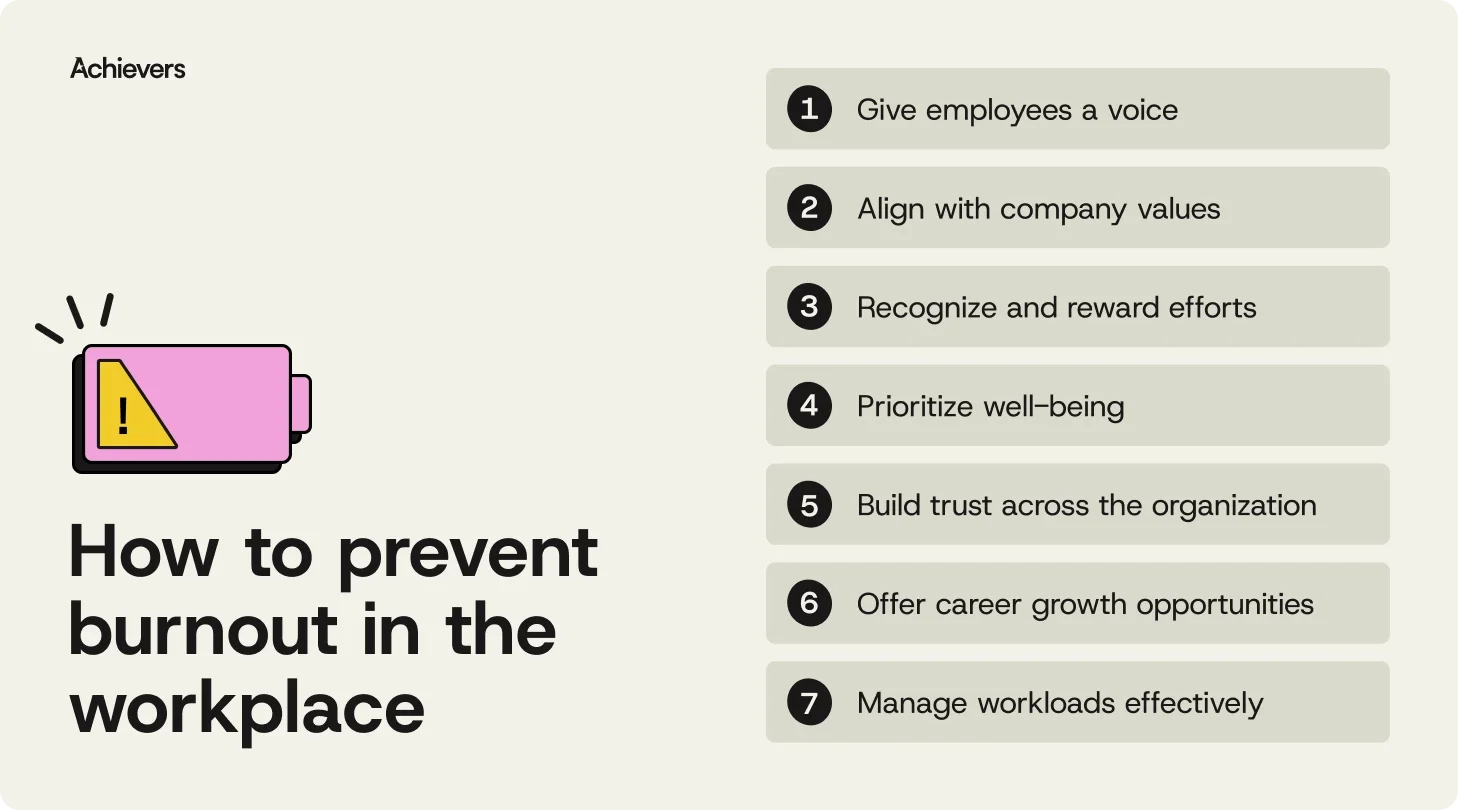Table of contents
Burnout is more than an individual problem — it’s an organizational headache. And it’s more common than you might think. According to SHRM’s 2024 Research Series, 44% of employees say they feel burned out at work. Burnout left unchecked can drain motivation fast — and take productivity, engagement, and retention down with it.
A few extra vacation days help, sure — but lasting burnout solutions come from building a culture where people can actually thrive, not just survive.
In this blog, we’re breaking down the signs and causes of burnout — with real strategies to build a workplace where employees feel appreciated, empowered, and motivated to do their best work.
What is burnout?
Burnout is a state of physical, emotional, and mental exhaustion caused by chronic stress or overwork. It can affect anyone, regardless of age, gender, or career, and while it isn’t permanent, it can take a serious toll on both well-being and performance if left unaddressed.
Signs and causes of workplace burnout
To address burnout, you first need to spot the signs and understand what’s driving it. That way, you can approach your team with more empathy and less guesswork.
Signs of burnout
- Disengagement: Employees seem less involved, showing little interest in or energy for their work.
- Decreased productivity: Tasks take longer to finish, and it feels like every step requires more effort.
- Increased mistakes: Small errors pop up more often — missing details, making avoidable mistakes.
- Frequent absence: More sick days or unexpected time off? It’s often a sign that something’s off.
- Irritability: Stress turns minor annoyances into major irritations, leading to short tempers.
Causes of burnout
- Excessive workload: Too much work, too little time — employees quickly burn out when demands outpace their capacity.
- Lack of autonomy: When employees don’t feel in control of their own work, burnout tends to follow.
- Rigid structure and policies: Overly strict rules and a lack of flexibility in the workplace can stifle creativity and efficiency.
- Lack of leadership support: Feeling undervalued or unheard is a sure way to fuel burnout
- Poor work-life balance: If employees are working long hours with little recovery, burnout is inevitable.
7 ways to prevent burnout in the workplace
Burnout might hit employees first, but the ripple effects reach the whole organization. When people are stretched thin, so is their work.
A culture that prioritizes employee well-being leads to better performance, stronger retention, and a more energized workforce. Supporting your employees isn’t only the right move — it’s a smart one for your bottom line, too.

Here are seven ways you can help prevent burnout in the workplace:
1. Give employees a voice
- Create open channels for feedback: Employees need to feel heard. Create safe spaces for feedback (think: anonymous surveys, open-door policies) so employees can speak up without fear. When people feel their concerns are taken seriously, they’re more engaged and less likely to burn out.
- Encourage transparency: Regular updates and clear communication reduce anxiety and make employees feel in the loop. No one likes surprises — especially when they come from a lack of communication.
- Act on feedback: When employees see their feedback lead to real changes, they feel valued. Asking isn’t enough — you need to listen, then act.
2. Empower people
- Provide autonomy in roles: People want to own their work. Give your team the freedom to make decisions and take initiative. Autonomy is a productivity and engagement booster.
- Encourage skill development: When employees feel like they’re growing, they’re less likely to feel stagnant — and burnout thrives in stagnation. Offer opportunities for talent development, training, and learning.
- Offer flexible work options: Whether it’s remote work, hybrid models, or flexible hours, giving employees control over their schedules helps them recharge and find balance.
3. Recognize and reward efforts
- Frequent recognition: Feeling unseen is a major contributor to burnout. Regular, genuine recognition shows employees you see their hard work, and it can double engagement and productivity. Recognition fuels motivation and keeps the engine running.
- Personalized rewards: Rewards should reflect the person receiving them. A gift card, a donation, or a personalized experience — showing you know what makes employees tick goes a long way.
- Peer-to-peer recognition: Recognition shouldn’t just be top-down. Encourage colleagues to shout out each other’s achievements. It builds camaraderie and creates a sense of belonging.
4. Prioritize well-being
- Promote work-life balance: It’s easy to say, “Take care of yourself,” but harder to do when your boss is sending emails at 10 p.m. Lead by example — set boundaries and encourage employees to disconnect after hours.
- Offer wellness programs: Access to mental health support, fitness programs, or stress management resources shows you care about more than just productivity. Well-being is key to long-term success.
- Create a supportive environment: Employees need to feel like they can ask for help when they need it. A culture of support helps prevent burnout by making it okay to not always be okay.
5. Build trust across the organization
- Foster open communication: Encourage honest, transparent conversations. Employees should feel like they can speak up without fear of judgment. This builds trust, which is crucial for a burnout-free culture.
- Be transparent with decision-making: Even if employees don’t always agree with decisions, they’ll appreciate the transparency behind them. It’s better to be upfront than to let uncertainty fester.
- Show empathy and support: Check in with employees on a personal level. Ask how they’re doing beyond the usual “How’s work?” A little empathy goes a long way in preventing burnout.
6. Offer career growth opportunities
- Clear pathways for advancement: When employees feel stuck, burnout is just around the corner. Provide career roadmaps and opportunities for growth, so employees can see their future at the company.
- Support mentorship programs: Mentorship offers guidance and a sense of direction. Connecting employees with mentors helps them grow and feel supported in their careers.
7. Manage workloads effectively
- Set realistic expectations: Be realistic about what your team can handle. Managers should check in regularly to ensure workloads are balanced and not overwhelming.
- Prioritize tasks: Help employees focus on high-impact work. When everything is a priority, nothing gets done. Clear prioritization helps keep burnout at bay.
- Provide support during peak periods: Workload spikes happen — it’s how you handle them that matters. Offer more resources or adjust deadlines when necessary. A little extra support during crunch time can prevent burnout from creeping in.
Workplace burnout: The hardest-hit industries
Burnout affects nearly every industry, but it looks different depending on the work. From long shifts to tight deadlines, each sector faces its own set of challenges. Knowing how burnout plays out in these industries helps employers tackle it head-on — before it becomes a bigger problem.
- Healthcare: Staffing shortages, paperwork, and lack of support all play a role in burnout across the healthcare sector. In fact, research from Achievers’ 2024 State of Recognition Report found that out of 3,600 global employees across 13 industries, healthcare workers are the most underappreciated industry of all. From mental health resources to creating a culture of appreciation, it’s clear there’s more work that needs to be done to make healthcare workers feel seen and valued.
- Manufacturing: Long hours and constant deadlines are a recipe for burnout. To keep it in check, focus on building a better culture, offering stronger management support, and creating a safe, supportive, and healthy environment where employees feel heard.
- Professional services: High stress, tight deadlines, and poor work-life balance? That’s the norm in fields like accounting and marketing, and it’s no wonder burnout’s so common. Focus on offering more flexible work options, recognizing employee achievements, and prioritizing mental health to keep your team engaged and motivated.
- Finance and insurance: With complex tasks, constant pressure, and sky-high expectations, it’s no surprise that 60% of finance professionals are seeking opportunities outside their industry. The solution? More resources, better tech, and stronger management support to ease stress and prevent burnout.
Stop burnout before it starts — with recognition
Long hours and heavy workloads can spark burnout — but feeling unseen is often what pushes people over the edge. When hard work goes unrecognized, motivation drops, stress rises, and burnout follows.
The good news? Recognition is one of the simplest, most effective ways to change that. Here’s why:
- Lifts morale: Appreciation gives employees a sense of purpose and relieves stress.
- Increases engagement: Recognizing effort fuels investment in the company’s success.
- Boosts motivation: Employees who feel recognized are inspired to give their best every day.
- Reduces turnover: When employees feel valued, they’re more likely to stick around.
- Drives performance: Recognition fuels energy and keeps employees all-in.
Build a burnout-free culture with Achievers
When the pressure’s on, employees don’t need another deadline. They need to feel valued. The key to turning it around? Recognition. It’s the fuel that keeps the fire going.
Achievers’ recognition platform makes it simple by slipping recognition into the tools your team already uses — think Teams, Slack, and Outlook. AI-powered insights highlight the behaviors that matter, while personalized rewards from a global marketplace make every “thank you” hit home. Plus, with 24/7 support in over 200 languages, Achievers helps your team stay engaged, motivated, and just the right amount of appreciated, cutting through stress and nipping burnout in the bud.
The best companies don’t just fight burnout. They avoid it altogether. Let Achievers help you create a culture where employees feel seen, supported, and ready to thrive.



